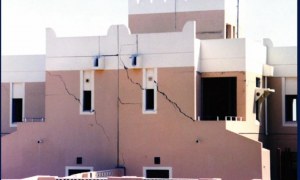🕑 Reading time: 1 minute
Triaxial shear strength test on soil measures the mechanical properties of the soil. In this test, soil sample is subjected to stress, such that the stress resulted in one direction will be different in perpendicular direction. The material properties of the soil like shear resistance, cohesion and the dilatancy stress is determined from this test. The test is most widely used and is suitable for all types of soils.Contents:
Triaxial Shear Test Apparatus
The important apparatus for triaxial shear test are:- Triaxial testing machine complete with triaxial cell : This unit have the provision to insert a cylindrical soil specimen that is sealed by means of rubber membrane to restrict the entry of lateral fluid. Radial fluid pressure and the vertical stress is applied by means of a piston arrangement. The unit also have the provision to prevent the drainage of specimen. The fluid pressure in the cell can be measured by means of a pressure gauge.
- Equipment for loading
- Equipment to measure load and Deformation : Proving is used to measure the load application by the piston. A dial guage is used to measure the deformation of the specimen
Triaxial Shear Test Principle
A cylindrical specimen, generally having a length to diameter ratio of 2, is used in the test and is stressed under conditions of axial symmetry in the manner shown in figure below.
Fig.1:Schematic Diagram of stress system at soil during triaxial test

Fig.2: Triaxial Test Apparatus
Triaxial Shear Test Procedure
The specimen can be prepared either remoulded or undisturbed. Undisturbed soil can be tested on soils that have sufficient cohesion. In order to make remoulded soils, cohesive soil is collected and compacted properly. Care is taken while preparing the cohesion less soils. The triaxial shear test can be conducted in different variations. The most commonly employed types are:- Unconsolidated Undrained Test (UU)
- Consolidated Undrained Test (CU)
- Consolidated Drained Test (CD)
1. Unconsolidated Undrained Test (UU)
As the name tells, the soil sample is subjected to cell pressure with no provision of drainage. Here the cell pressure is maintained to a constant value and the applied deviator stress is increased till the sample fails. This is called as quick test.2. Consolidated Undrained Test (CU)
Here, during the application of cell pressure on the sample, drainage is permitted. And the deviator stress is applied keeping the cell pressure constant and no provision of further drainage.3. Consolidated Drained Test (CD)
This test is also called as drained or slow test. Here the deviator stress is increased by allowing the drainage to happen as it was and the cell pressure is also kept constant. Here the rate of loading is applied slowly so that excess pore pressure is not developed within the sample The prepared specimen is enveloped in the membrane and positioned in the triaxial cell. To this, the desired lateral pressure is applied. Till the specimen fails, the lateral pressure is applied. The vertical deformation and the load readings are recorded. The main objective of the test is to determine the values of cohesion and angle of internal friction. To determine these values, three different lateral pressure values have to be tested on the sample.Calculations
The test specimen is subjected to all around lateral pressure (





Fig.3: Determination of Stress parameters by Mohr's Circle
Effective Stress Conditions
The effective stresses acting on the soil specimen during testing are shown in figure. In this case effective minor principle stresses is equal to the cell pressure (fluid pressure) minus the pore pressure. The major principle stress is equal to deviator stress plus the cell pressure. Hence, the effective major principle stress

Fig.4.Effective Stress Determination by Mohr's Circle




Pore water pressure measurement
Pore water pressure must be measured under conditions of no flow either out of or into the specimen, otherwise the correct pressure gets modified. It is possible to measure pore water pressure at one end of the specimen while drainage is taking place at the other end. The no flow condition is maintained by the use of the null indicator, essentially a U-tube partly filled with mercury.Advantages of Triaxial Test
- The stress distribution on the failure plane is uniform.
- The specimen is free to fail on the weakest plane
- There is complete control over the drainage.
- Pore pressure changes and the volumetric changes can be measured directly.
- The state of stress at all intermediate stages upto failure is known. The Mohr circle can be drawn at any stage of shear.
- This test is suitable for accurate research work and the apparatus adaptable to special requirements such as extension test and tests for different stress paths.
Disadvantages of Triaxial Test
- The apparatus is elaborate, bulky and costly.
- The drained test takes place a longer period in comparison with a direct shear test.
- It is not possible to determine the cross sectional area of the specimen at larger strains, as the assumption that the specimen remains cylindrical does not hold good.
- The strain conditions in the specimen are not uniform due to frictional restraint produced by the loading cap and the pedestal disc. This leads to the formation of the dead zones at each end of the specimen.
- The consolidation of the specimen in the test is isotropic, whereas in the field, the consolidation is generally anisotropic.


